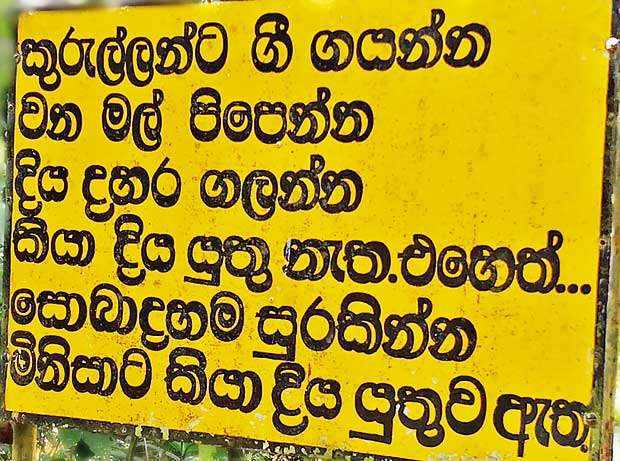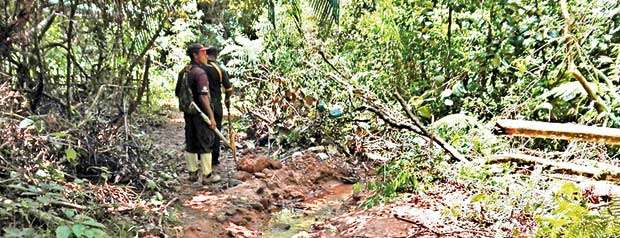Reply To:
Name - Reply Comment
Last Updated : 2024-04-19 19:28:00

 When you put away all the modern conveniences for a few days to step into a rainforest, you don’t expect the trip to be comfortable. It’s raining, it’s hot, you’re dirty, but you feel more alive once you have arrived in Sri Lanka’s largest rainforest, Sinharaja, thanks to its unique ecosystem and rich biodiversity. Walking under the tall trees and listening to the high pitched screech of a million bugs and the twitter of the birds are all too wonderful to explain.
When you put away all the modern conveniences for a few days to step into a rainforest, you don’t expect the trip to be comfortable. It’s raining, it’s hot, you’re dirty, but you feel more alive once you have arrived in Sri Lanka’s largest rainforest, Sinharaja, thanks to its unique ecosystem and rich biodiversity. Walking under the tall trees and listening to the high pitched screech of a million bugs and the twitter of the birds are all too wonderful to explain.
Be that as it may, what we saw when walking on the Kudawa access road of Sinharaja last week was a bulldozer, which was pushing trunks and branches, already cut up, toward the edge of the road. The road was subject to repair and being expanded. The bulldozer was advancing and pushing the blade along the surface of the soil in order to remove brushwood and small trees.
Environmentalists warn that the ongoing repair work of Kudawa access road to Sinharaja- which is part of a bigger eco-tourism project (ESCAMP project) for the forest and funded by the World Bank- don’t bode well for the rich biodiversity in the forest. They warn that roads and development work in Sinharaja can open a Pandora’s Box of problems, such fragmenting habitats, altering microclimates, blocking movement of wildlife and claiming animals as road kill.

There are three access points in Sinharaja namely: Pitadeniya, Kudawa, and Morningside. Kudawa is a famous entry point with tourists. Figures show around 30,000 visitors having arrived at Sinharaja annually using the Kudawa entrance. In 2015, the Kudawa entrance recorded 41, 231 entries comprising local and foreign visitors.
The 1.4 kilometre road, which starts from the Kudawa ticket counter, ends at Research, Education and Extension Centre; which dates back to 1970s. We spoke to the Conservator General of Forests, Department of Forest, S. A. Anura Sathurusinghe. He had retired from the position less than two weeks ago after serving the department for 36 years. He said the road was constructed by the government which was in power in the 1970s to transport timber.
“Following the declaration of Sinharaja as a World Biosphere Reserve in 1978 and a World Heritage Site in 1988, timber transport was immediately stopped. Since then, no vehicles except vehicles carrying equipment belong to researchers, entering the Research, Education and Extension Centre and vehicles belong to the Forest Department have been allowed to use that road,” he said.
Heavy rains had created huge holes on the road and trees had fallen on the road making it unsafe for anyone to walk along, he said. Minor landslides and floods had also affected the road last year. According to him, there was an accident last year where a foreign female traveler had fallen into a hole on the road and broken her arm.
“Many had complained to the Forest Department, asking us to repair the road. Despite a few visitors who engage in illegal activities, all the visitors cannot be punished. So, what we are doing is restoring the old road; not destroying the environment,” he stated.

A bulldozer moves trunks and branches, already cut up, towards the edge of the Kudawa access road in Sinharaja
Environmentalists from a number of environmental organisations maintain that environmental disasters often begin as a narrow slice into the forest. Dr. Hemantha Perera of the Wildlife & Nature Protection Society (WNPS) opined that nature should be protected from spineless quasi environmentalists and officials who support unwarranted developments for a few dollars.
“The truth is that all these politicians are bluffing. If the culprits are in their camp, then the sins are forgiven. Ethanol becomes water. Pepper becomes papaya seeds. Imported areca nuts become local. Cleared pristine jungle becomes resettling old villages. Some cannot remember emptying bank coffers to their pockets. Destruction becomes development,” Dr. Perera stated.
He alleged that destroying Sinharaja is the follow up of what was done to Wilpattu National Park.
“Some time ago, one idiotic Government wanted raw material for a plywood factory and cut acres and acres of trees from the heart of Sinharaja. It has been always corrupt politicians with spineless administrators toeing the line for their survival and promotions,” he said.

Parts of the road damaged due to floods

The new drainage system

How the road looks after minor landslides which took place in 2017
Speaking about the issues faced by tourists travelling on the Kudawa access road, he was of the view that visiting nature has to be done on terms of the nature. He said that Sinharaja should not be opened to lazy visitors who want to travel in limousines.
“Already heavy machinery has been used to widen the road from the ticket office to the gate. In other countries, they do not allow any Tom, Dick and Harry to destroy even an inch of their forests, therefore, we have to walk along trails as anyone else and see the nature as nature. How come that our authorities are feeling so compassionate about the comforts of the visitors when it comes to our sacred forests?” asked Dr. Perera.
The Sinharaja is the only home for many of the threatened endemic animals and plants; including several amphibian species whose presence has been recorded at on one single location. Environmentalists claim that in great forests like Sinharaja, that consist of several stories of vegetation and trees of every diameter, roads can have an array of deleterious effects on the forests and their wildlife.
Jayantha Wijesinghe, attached to Rainforest Protectors Sri Lanka, told the Daily Mirror that if the authorities wanted to repair the road, they could have just repaired it without clearing trees and expanding its width.
“Officers say that this is for the convenience of the general public. They also say that they will not allow any vehicles to ply on this road. But, why are they building such a long and broad road if they don’t want people to use it for vehicles?” he queried.
Sinharaja has a uniquely complex structure and possesses a humid climate that sustains a huge number of endemic species. These development activities can result in a diminished or a fragmented wildlife population, and can lead to local extinctions, he said.
The effects that roads have on local ecosystems extend far beyond the locations of the roads themselves. “Roads can make large-scale change within the rainforest. This includes changes in the temperature and humidity of air and soil and the movement of animals,” Wijesinghe explained further.
Despite a few visitors who engage in illegal activities, all the visitors cannot be punished
Sathurusinghe
Ven. Vekandawala Rahula Thera of Sinharajaya Surakina Janatha Pawra (Peoples’ Wall to Protect Sinharaja) said that the Rajapaksa administration in 2011 commenced the construction of a six km road through Elumakanda and Beragala proposed sanctuaries adjoining Sinharaja National Heritage Wilderness Area. However, the project was suspended after UNESCO urged the Ministry of Environment to explain what was going on in the area.
The priest said that the roads enable loggers, hunters, farmers, ranchers and miners to convert rain forests into economic opportunities. “Roads are the seeds of tropical forest destruction,” he stated.
Recently, five foreign nationals had been arrested for attempting to smuggle out gene samples of endangered species, plants and insects from Sinharaja. Rahula Thera believes facilitating such tourists, aka smugglers, by developing roads cannot be accepted.
Developing countries like Sri Lanka are supposed to maintain a balance between economic benefits through tourism and environmental management. The Daily Mirror met two residents of Kalawana area. They are heads of two environmental organisations. We met the Chairman of National Environmental Foundation, Suranga Buddhika and the President of Sinharaja Sumithuro, Wasantha Kumara.
Both are of the view that rapidly expanding economies often worsen the friction between wild lands that protect native fauna and flora and the new development programmes that target tourism and economic welfare.
“The officials backing these projects cite increased economic opportunities for local people as well as improved facilities for visitors. Vote-seeking politicians and environmentally-insensitive investors do not care how environmentally detrimental these type of projects are. The biggest road projects are often being supported by international lenders. This project too is funded by World Bank. Educating such decision-makers needs to be done,” Suranga said.
Meanwhile, Wasantha stated that projects like ESCAMP can result in diminished or fragmented wildlife populations, and can lead to local extinctions. “For some creatures, especially those with low reproductive rates, development work that takes into account roads could potentially become death zones that help propel the species toward local extinction,” he said.
The truth is that all these politicians are bluffing
Dr. Perera
Road construction is now common through wilderness and protected areas in tropical and subtropical countries with its consequences affecting their high native biodiversity. Regarding this Kudawa access road development issue, Sri Lankan environmentalists have different perspectives. Senior environmental lawyer Jagath Gunawardena is one whose opinion carries much weight.
He said that when he had visited the Sinharaja in November last year the Kudawa access road was not in a good condition for the travelers to safely walk on. He said that it badly needs repair.
Speaking about environmental damage, he said that as far as he was concerned, the destruction that had taken place, owing to clearing a number of trees, is not an irreparable damage. Gunawardena said the 1.4 km road from the ticket centre to the Research, Extension and Education Center did not have an important biodiversity. According to him, plants that were removed when clearing and expanding the road can be easily found inside the forest too.
“I’m not denying the fact that a certain amount of damage has taken place, but it cannot be identified as an environmental destruction. The term environmental destruction has weight and is a bigger subject. There were a number of invasive species along the road which anyway should have been removed. When a few plants and trees are cut down probably for a fair reason, we cannot call it environmental destruction,” he said.
Why are they building such a long and broad road if they don’t want people to use it?
Jayantha Wijesinghe
ESCAMP (Eco System and Conservation and Management Project) is a World Bank funded development project which possesses a nature-based tourism capacity and facilities in the Sinharaja forest and buffer zone in the Ratnapura District. The project targets to completion by 2021.
The project report mentions the absence of an attractive entry point, inadequate accommodation facilities, poor access roads, problems in interpretation service and the less participation of local communities in tourism as the major drawbacks of nature based tourism in Sinharaja. Therefore the area covering Sinharaja and its peripheral forest from Ratnapura District is proposed for this ESCAMP. The project is expected to enhance nature base tourism and attract more local and foreign tourists by providing appropriate facilities.
Former Director General of Wildlife Department Dr. Sumith Pilapitiya, who serves World Bank, has also made his contributions to the ESCAMP project proposal.
As part of the project, improvements are expected in access roads including the Kudawa access road, nature trails, bungalows, Research and Environmental Education Center (REEC) and the water body near the REEC.
Speaking on the project, former Conservator General of Forests, Department of Forest S. A. Anura Sathurusinghe said that the project differs from the typical environmental projects because the donor does not pressure the receiver – Forest Department to do as exactly what the project proposal says. “I have been working in forests all my life. We are here for environmental conservation, which is our duty and responsibility. None of us working in this project wants to destroy nature,” he further said.
Roads are the seeds of tropical forest destruction
Rahula Thera
Forester of Sinharaja is probably the person with the best knowledge about every inch of Sinharaja. In an interview with the Daily Mirror, Forester, Sinharaja, Forest Department K.D.A.P. Jayasinghe said that the access road of Kudawa was designed and planned by the Engineering Department of Ratnapura Provincial Council, minimizing environmental impacts.
According to him, they had to stop the development work of this road in 2014 due to lack of ministry funds. Now that we have found an international donor, development work has been restarted, he said. The Forest Department had also wanted to develop a proper drainage that can handle the intense runoff from heavy tropical rainfall. They have also come up with the interlock design for the road without putting carpet or fully covered concrete, so that small plants would grow between small inches in the gaps of interlock, giving a natural look to the road.
He said a string of complaints received from visitors and disabled visitors comprised requests to repair the road. “We have to think about all the parties. Our purpose here is to facilitate the visitors, not support environmental destruction,” said Jayasinghe.
Referring to the allegations of facilitating poachers and hunters, Forester said that the hunters, who were recently arrested, had used the other entrance road which runs through the village. Villagers want their road to be developed, he said.
Damage has taken place, but it cannot be identified as an environmental destruction
Gunawardena
When asked about environmental and social management plans of ESCAMP, Jayasinghe said all work would be carried out in such a manner that the destruction or disruption to the fauna and their habitants is minimised. According to the project report, Rs.153, 000 has been estimated as monitoring cost for the environmental management plan while monitoring cost for social management plan is Rs.110, 000. Although funds are available for monitoring and ways to manage environmental impacts have been detailed comprehensively in documents, whether they are practiced in reality is a question.
We live in an era in which many of the world’s best wildernesses, from the Amazon in Brazil to Daintree in Australia have been pierced by roads and new development projects. Indubitably, Sri Lanka too should create economic opportunities from its natural resources through eco-friendly tourism; yet not at the expense of wildlife and giant forests that every country is not blessed with.
Pix by Pradeep Pathirana

Add comment
Comments will be edited (grammar, spelling and slang) and authorized at the discretion of Daily Mirror online. The website also has the right not to publish selected comments.
Reply To:
Name - Reply Comment
On March 26, a couple arriving from Thailand was arrested with 88 live animal
According to villagers from Naula-Moragolla out of 105 families 80 can afford
Is the situation in Sri Lanka so grim that locals harbour hope that they coul
A recent post on social media revealed that three purple-faced langurs near t